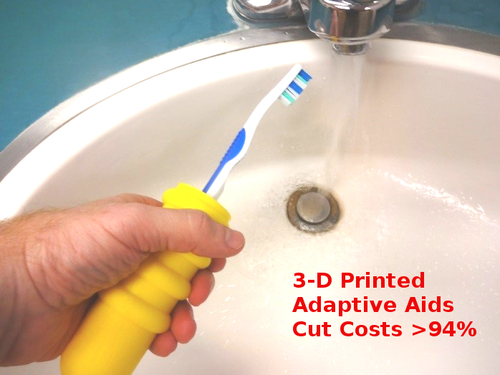Economic Potential for Distributed Manufacturing of Adaptive Aids for Arthritis Patients in the U.S.

|
By Michigan Tech's Open Sustainability Technology Lab.
Wanted: Students to make a distributed future with solar-powered open-source RepRap 3-D printing and recyclebot recycling. |

|
| 3D Printing Adaptive Aids for Arthritis Patients |
|---|
Error in widget YouTube: Unable to load template 'wiki:YouTube' |
Source
- Nicole Gallup, Jennifer K. Bow, and Joshua M. Pearce. Economic Potential for Distributed Manufacturing of Adaptive Aids for Arthritis Patients in the U.S. Geriatrics 2018, 3(4), 89; https://doi.org/10.3390/geriatrics3040089 open access
- To edit models see OpenSCAD and FreeCAD
- Get help or help someone else - meet at Makers Making Change
Abstract
By 2040, more than a quarter of the U.S. population will have diagnosed arthritic conditions. Adults with arthritis and other rheumatic conditions earn less than average yet have medical care expenditures that are over 12% of average household income. Adaptive aids can help arthritis patients continue to maintain independence and quality of life; however, their high costs limit accessibility for older people and the poor. One method used for consumer price reduction is distributed manufacturing with 3-D printers. In order to assess if such a method would be financially beneficial, this study evaluates the techno-economic viability of distributed manufacturing of adaptive aids for arthritis patients. Twenty freely accessible designs for 3-D printable adaptive aids were successfully fabricated on low-cost desktop 3-D printers and performed their functions adequately. The financial savings averaged >94% compared to commercially-available products. Overall, twenty adaptive aids were printed for US$20 of plastic; while on average, each adaptive aid would save over US$20. As printing a tiny subset of the adaptive aids needed by a single patient would recover the full capital and operational costs of a low-cost 3-D printer, it can be concluded that there is considerable potential for distributed manufacturing to assist arthritis patients.
Keywords
distributed manufacturing; additive manufacturing; 3-D printing; consumer; economics; open-source; arthritis; adaptive aid; economics; motor skills; person–environment interaction; cost-effective
Gallery
Click on the hyperlink below the image to download the stl for printing and the CAD for customization.
- Arthritis Adaptive Aid
- Vehicle Transfer Handle.PNG
- Jaropener.jpeg
- ArthritisDrawerHandle.jpg
- 20181020 172150.jpg
- 20181021 114449.jpg
- LightSwitchExtensionLever.jpeg
- SockAid3.jpg
- IMG 20181022 131458.jpg
- WristAdaptiveAid.jpg
- BTJ zipperAide.jpg
- Knitting Aid.JPG
- IMG 20181022 221905.jpg
- Nail clipper holder.jpg
- Arthritis scissors.jpg
- Easy Eye Dropper.PNG
- IMG-0620.JPG
- Shoeaid.jpg
- Peeling Aid.jpg
- Admitche keyturn.jpg
- Arthritis Type Aid.jpg
- EasyCarHandle.JPG
- IMG 0662.jpg
- Dogsnap.jpeg
- Doorknob Extender.jpeg
- Gascapwrench.jpeg
- Tube squeeze.jpg
- Light switch extension.jpg
- Arthritis aid.jpg
- Arthritis toothbrush.jpeg
- Fishing Reel Aide.jpg
- Vegetable plate.jpeg
- Smart Phone Document Scanning Stand.JPG
- IMAG6705.jpg
- Peeler.JPG
- Lloxner phone case.png
- Gas Cap Wrench.jpg
- Picture of Print.jpg
- Arthritis Aide wrm.png
See also
- Emergence of Home Manufacturing in the Developed World: Return on Investment for Open-Source 3-D Printers
- Life-cycle economic analysis of distributed manufacturing with open-source 3-D printers
- Distributed Manufacturing of Flexible Products- Technical Feasibility and Economic Viability
- Impact of DIY Home Manufacturing with 3D Printing on the Toy and Game Market
- Quantifying the Value of Open Source Hardware Development
- Open-source, self-replicating 3-D printer factory for small-business manufacturing
- Distributed manufacturing with 3-D printing: a case study of recreational vehicle solar photovoltaic mounting systems
- Global value chains from a 3D printing perspective
| This page is part of an international project hosted by MOST to use RepRap 3-D printing to make OSAT for sustainable development. Learn more.
Research: Open source 3-D printing of OSAT • RecycleBot • LCA of home recycling • Green Distributed Recycling • Ethical Filament • LCA of distributed manufacturing • RepRap LCA Energy and CO2 • Solar-powered RepRaps • solar powered recyclebot • Feasibility hub • Mechanical testing • Lessons learned • MOST RepRap Build Make me: Want to build a MOST RepRap? - Start here! • Delta Build Overview:MOST • Athena Build Overview • MOST metal 3-D printer • Humanitarian Crisis Response 3-D Printer |
Other aids
In the News
- 3-D Printing Offers Helping Hand to People with Arthritis - MTU News 13.3k, Newswise 107k, Health News Digest, Health Management Technology, Scienmag
- How Cost Effective are 3D Printed Adaptive Aids for Arthritis Patients? -3D Print 52.7k
- Reducing Pain Doesn’t Have to be a Pain - Fabbaloo 116k
- 3-D printing offers helping hand to people with arthritis- Medical Express 19.4k, NJUS
- I sussidi per artritici stampati in 3d - Stampare in 3D
- 3D printing aids for people with arthritis 3Ders 82.4k
- Creating 3D-Printed Adaptive Aids for Individuals with Arthritis ECN 93.8k
- 3D printing offers helping hand to patients with arthritis Eureka Alert 18.7k, Science Daily 3281
- Researchers Use 3D Printing to Design Inexpensive Adaptive Aids for Arthritis Patients AZO Materials 35.3k
- 3D打印设计的小工具,辅助关节炎患者 - Nanjixiong 62.6k
- 3D-gedruckte Hilfsmittel für Personen mit Arthritis 3DRuck
- 3D printing aids for people with arthritis 3D Print Home
- 3D-printed adaptive aids can benefit patients with arthritis - News Medical 11.3k
- Low-Cost 3D-Printed Adaptive Aids for Arthritis Patients Medgadget 88k
- 密歇根理工大学通过3D打印辅助治疗关节炎患者 3Dhoo
- 密歇根理工大学通过3D打印辅助治疗关节炎患者 3DDay
- 3D Printed Adaptive Aids Can Benefit Arthritis Patients Med India 11k
- 密歇根理工大学通过3D打印辅助治疗关节炎患者 3D Print of the Week 8457
- 技术造福人类 3D打印辅助关节炎患者 CNMO 10.4k
- 3-D Printing Offers Helping Hand to People with Arthritis Orthofeed
- 3D-printed adaptive aids for arthritis patients Medical View
- Michigan Tech students 3D-print devices to aid arthritis sufferers The Fabricator 96.8k
- Long Room
- Why you should give your grandparents a 3D printer for Christmas - The Conversation 3707,
Houston Chronicle 941, SF Gate 1383, San Francisco Chronicle 5.8k, India TV 6619, Seattle Pi 12.9k WTop 13.6k, Houston Chronicle 16.8k Times Union 24.7k My SanAntonio 24.9k, LMT Online 52.6k, CT Post 54.9k, San Antonio Express 71.8k, New Haven Register 79.2k, Stamford Advocate 92.6k News Times 99.2k, Greenwich Time , The Telegraph, Midland Daily News, My Plain View, New Cannan News, Edwardsville Intelligencer, Huron Daily Tribune, My Journal Courier, Register Citizen, FairField Citizen, Middletown Press, MRT, The Hour, Beaumont Enterprise, Idaho Press Tribune, West Port News, MENA FN, Give Your Grandparents a 3D Printer for Christmas Industrial Equipment News
- Fast Company 2110
- Why you should give your grandparents a 3D printer for Christmas The Star (Malaysia) 4820
- 3D printers are great for seniors Techapeak
- How 3D printing is helping arthritis patients 3D Printing Industry 61k
- 3D Printer for Patients in Assisted Living? Yes! Orthopedics This Week, Medical Health News
- 3D printers might be the future of Christmas gifts for grandma and grandpa Soo Today 67.3k
- 3D printers might be the future of Christmas gifts for grandma and grandpa Timmins Today
- Why you should give your grandparents a 3D printer for Christmas Salon 4581
- Futuros pesquisadores criam utensílios para ajudar pessoas com artrite levar uma vida normal Ceticisumo
